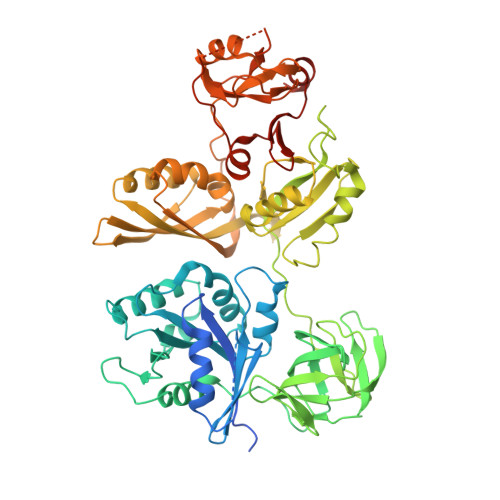Structural and Functional Analysis of BipA, a Regulator of Virulence in Enteropathogenic Escherichia coli.
Fan, H., Hahm, J., Diggs, S., Perry, J.J., Blaha, G.(2015) J Biological Chem 290: 20856-20864
- PubMed: 26163516
- DOI: https://doi.org/10.1074/jbc.M115.659136
- Primary Citation of Related Structures:
4ZCI, 4ZCK, 4ZCL, 4ZCM - PubMed Abstract:
The translational GTPase BipA regulates the expression of virulence and pathogenicity factors in several eubacteria. BipA-dependent expression of virulence factors occurs under starvation conditions, such as encountered during infection of a host. Under these conditions, BipA associates with the small ribosomal subunit. BipA also has a second function to promote the efficiency of late steps in biogenesis of large ribosomal subunits at low temperatures, presumably while bound to the ribosome. During starvation, the cellular concentration of stress alarmone guanosine-3', 5'-bis pyrophosphate (ppGpp) is increased. This increase allows ppGpp to bind to BipA and switch its binding specificity from ribosomes to small ribosomal subunits. A conformational change of BipA upon ppGpp binding could explain the ppGpp regulation of the binding specificity of BipA. Here, we present the structures of the full-length BipA from Escherichia coli in apo, GDP-, and ppGpp-bound forms. The crystal structure and small-angle x-ray scattering data of the protein with bound nucleotides, together with a thermodynamic analysis of the binding of GDP and of ppGpp to BipA, indicate that the ppGpp-bound form of BipA adopts the structure of the GDP form. This suggests furthermore, that the switch in binding preference only occurs when both ppGpp and the small ribosomal subunit are present. This molecular mechanism would allow BipA to interact with both the ribosome and the small ribosomal subunit during stress response.
- Department of Biochemistry, University of California, Riverside, California 92521.
Organizational Affiliation:



















